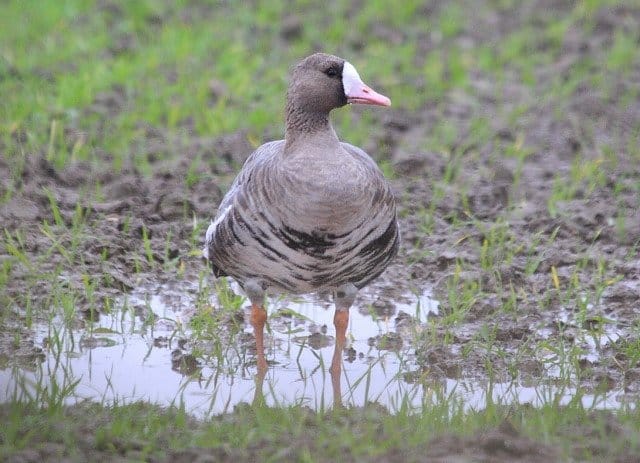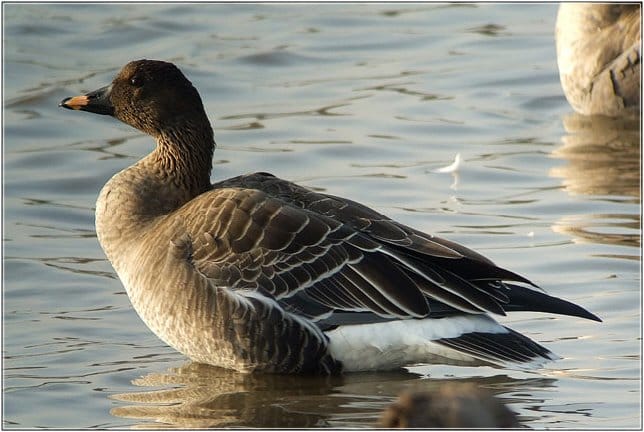Anyone thinking that it’s time to slow down needs to think again. The temperatures may not be conducive to shorts and T-shirt but there is still some great early winter birding to be had in Britain right now.
The highlight of the early winter period for many over here has been an unusually large influx of Greater White-fronted Geese along the full span of the East Coast before penetrating further west and inland over the past 2-3 weeks. We get two races of Greater White-fronted Goose in Britain ‘Greenland’ White-fronted Goose Anser albifrons flavirostris and the nominate race Anser albifrons or ‘European’ White-fronted Goose.
 ‘European’ White-fronted Goose
‘European’ White-fronted Goose
Whilst White-fronted Geese are probably the most numerous of the goose species to winter in Western Europe, there continues to be conservation concerns about the less numerous Greenland race with a rapid decline in the population particularly during the last decade.
The current influx has almost exclusively involved European breeding birds, probably due to weather conditions in mid-November. High pressure over mainland Europe sweeping them across from Russia before strong southerly/southeasterley winds nudging them north and east over the North Sea and into Britain; this Autumn/Winter may turn out to be one of the best in recent memory for European White-fronted Geese numbers in Britain.
In my home county of Northumberland roughly at the centre of the British east coast the largest flock I can find in the record books was one of 106 during a winter influx in 1996. As I write we still have between 4-500 White-fronts lingering in the county and it will be interesting to see just how many get reported in total for the period. There has already a single flock count of 335 from one site.
The same weather conditions brought unusually high numbers of Tundra Bean Geese too, many of which were in with flocks of White-fronted Geese and represented an added bonus to those braving the drizzle and checking out some of the flocks that appeared in winter stubble fields. Dig way back into the records to the 18th Century and it is odd to think that Bean Geese were once described as the most common grey geese in Northern England in winter. Recent years have seen very few records, no Tundras were seen at all in 2009, so this year’s mini-invasion of perhaps 30-50 individuals to date is quite remarkable in comparison.
 Tundra Bean Goose (courtesy Gary Woodburn)
Tundra Bean Goose (courtesy Gary Woodburn)
Continuing with the goose theme, the origins and movements of some of the geese that turn up in Britain continue to add to our knowledge as a result of neck-ringing schemes that allow individuals to be monitored such as these and DNA analysis results that help sort out the likely origins of some potentially rarer visitors. I’m sure the latter will have been a little disappointing for all those hoping that those particular Snow Geese had made the hop across the Atlantic, though at best that particular scenario for those individuals would perhaps be best described as ‘wishful thinking’.
What is for sure is that there isn’t a better time than right now to get acquainted with geese whether it’s finding the tell-tale fiery orange-banded bill amongst the more numerous Pink-feet or the flash of a white forehead amongst the regular Greylag Geese they add a splash of colour and variety to the short winter days. Get out, get goosing!













Ah, the geese: the one bird group I miss with a passion now that I live inland. The German Baltic coast used to be amazing in October. We once conducted a coordinated goose count at a roost by counting all the groups flying away from the bay where they had spent the night, and after adding up all the numbers we got to 120,000.
That was in the late 1990s before they started to shift their migration routes to the south (Saxonia).
Here around Heidelberg, the only geese we get a escape and/or feral, and a common sight is a mixed goose party of 30-50 birds, mostly Canada with Egyptian Geese, Swan geese, Pink-feet, Hybrids Pink-feet x Swan, and feral Greylag.
Sad, sad, sad. And a constant reminder of the coast’s glories.
Thanks for sharing the excitement of goose migration!